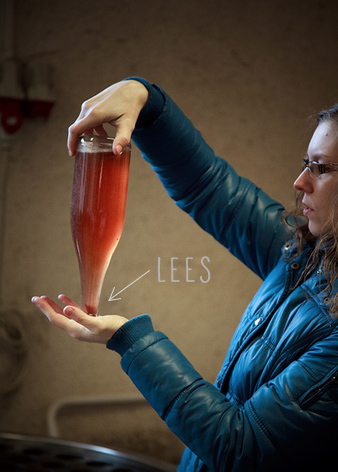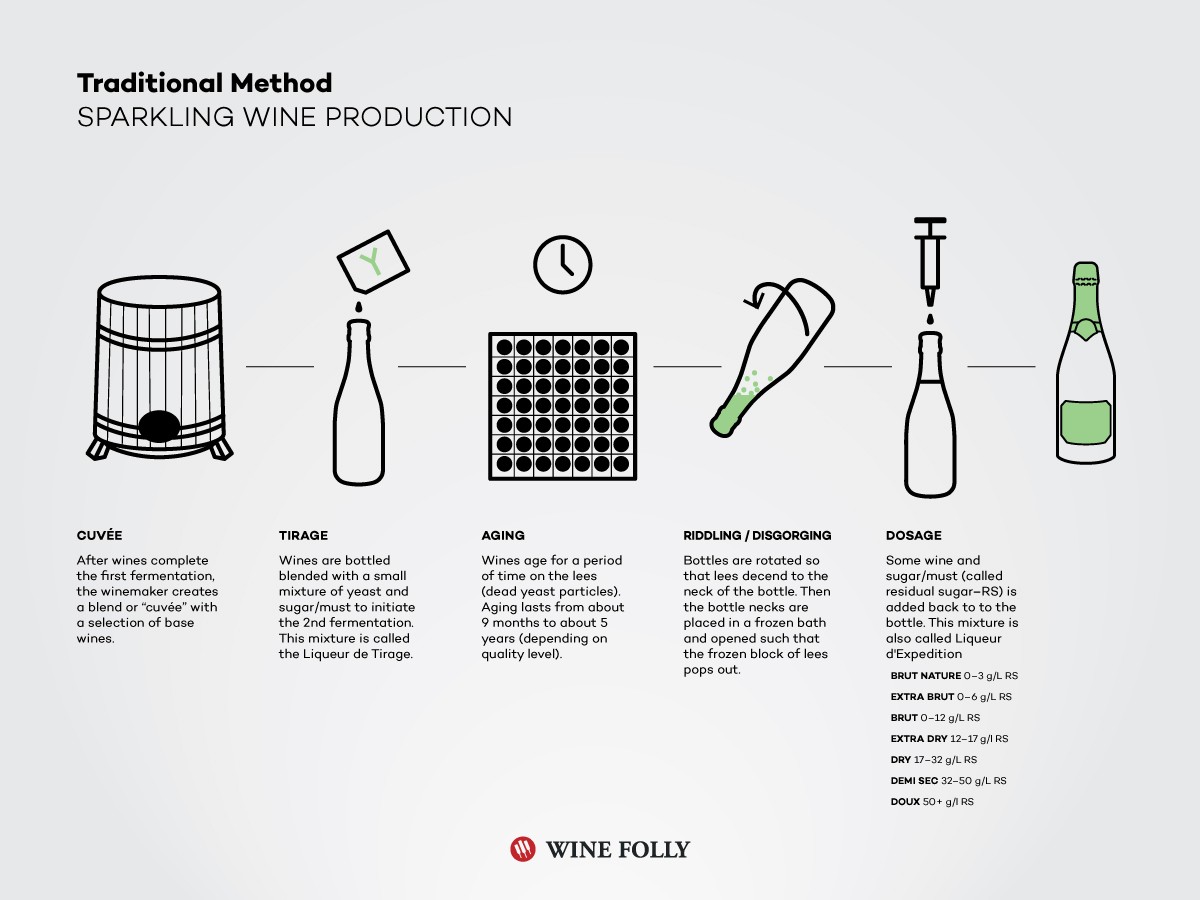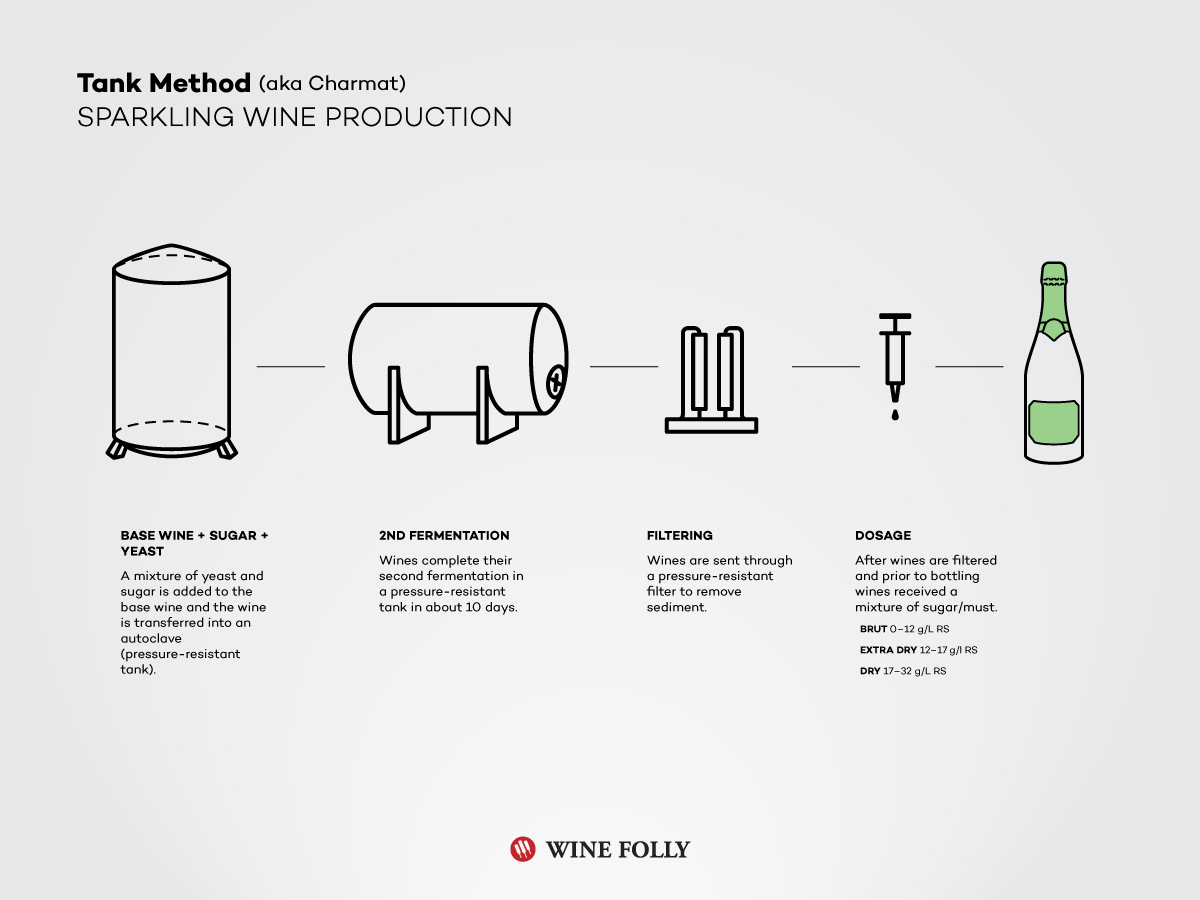Learn the primary methods used for sparkling wine production including the traditional Champagne method and the tank method (used for Prosecco).
Sparkling wine might just be the most technical of all wines in the world–even if it is so easy to drink! The reason most sparkling wine is so complex is because of the need for two fermentations; one to make wine and the other to make bubbles. Since sparkling wines were first introduced (starting in the mid 1500’s), several processes have been developed and each result in a unique sub-style of sparkling wine. Take a look at the major sparkling wine production methods and which wines are made with each technique.
How Sparkling Wine is Made
There are 6 major methods by which sparkling wines are produced, each resulting in a different carbonation level and, ultimately, a different style of bubbly! We’ll discuss all the styles, but the two worth paying attention to the most are Traditional Method (used for Champagne, etc) and Tank Method (used for Prosecco, etc).
- Traditional Method
- Tank Method
- Transfer Method
- Ancestral Method
- Continuous Method
- Carbonation

Under Pressure
Sparkling wines have different pressure levels which affect our perception of their taste. The higher the pressure, the more fine the bubbles. Here are some accepted terms for sparkling wine in terms of bubble pressure:
- Beady: a wine bottled with <1 additional atmosphere of pressure (14.7 psi). Bubbles appear on the sides of the bottle (or glass) when the wine is opened.
- Semi-Sparkling: (a.k.a. Frizzante, Spritzig, Pétillant, Pearl) a wine with 1–2.5 atmospheres (14.7–37 psi) of pressure that is slightly sparkling.
- Sparkling: (a.k.a. Mousseux, Crémant, Espumoso, Sekt, Spumante) The EU has deemed that bubbly wines with 3 or more atmospheres can be labeled as sparkling.
Traditional Method
a.k.a. Méthode Champenoise, méthode traditionnelle, Methode Cap Classique, Metodo Classico, klassische flaschengärung
Examples: Cava, Champagne, Crémant, some Sekt, Italian Metodo Classico wines (including Franciacorta and Trento)
Bottle Pressure: 5–7 atmospheres or ~75–99 psi
The traditional method of sparkling winemaking was awarded a UNESCO heritage in Champagne in 2015. It is–arguably–the most appreciated method for sparkling wine production in terms of quality, and at the same time it is also the most costly in terms of production. The most important facet of the traditional method is that the transformation from a still to a sparkling wine occurs entirely inside the bottle.
- Base Wine or “Cuvée”: grapes are picked (usually just a tinsy bit younger to preserve acidity) and fermented into a dry wine. The winemaker then takes the various base wines and blends them together into what the French call a “cuvée”, which is the final sparkling wine blend.
- Tirage: Yeast and sugars are added to the cuvée to start the second fermentation and wines are bottled (and topped with crown caps).
- 2nd Fermentation: (inside the bottle) The second fermentation adds about 1.3% more alcohol and the process creates CO2 which is trapped inside the bottle thus carbonating the wine. The yeast dies in a process called autolysis and remain in the bottle.
- Aging: Wines are aged on their lees (the autolytic yeast particles) for a period of time to develop texture in the wine. Champagne requires a minimum of 15 months of aging (36 mos for vintage Champage). Cava requires a minimum of 9 months of aging but requires up to 30 months for Gran Reserva Cava. Most believe the longer the wine ages on its lees, the better.
- Riddling: Clarification occurs by settling the bottle upside down and the dead yeast cells collect in the neck of the bottle.
- Disgorging: Removing sediment from bottle. The bottles are placed upside down into freezing liquid which causes the yeast bits to freeze in the neck of the bottle. The crown cap is then popped off momentarily which allows the frozen chunk of lees to shoot out of the pressurized bottle.
- Dosage: A mixture of wine and sugar (called Exposition liqueur) is added to fill bottles and then bottles are corked, wired and labeled.
Tank Method
a.k.a. Charmat Method, Metodo Italiano, Cuvée Close, autoclave
Examples: Prosecco, Lambrusco
Bottle Pressure: 2–4 atmospheres (ATM) 30–60 psi
The tank method came about during the industrial advancements made in the early 20th century and is the main process used for Prosecco and Lambrusco wines. The major difference between the tank method and the traditional method is the removal of the individual bottle as the vessel used to turn a still wine into a sparkling one. Instead, base wines are added together with the sugar and yeast mixture (Tirage) into a large tank. As the wine has a second fermentation, the CO2 released from the fermentation causes the tank to pressurize, whereafter wines are then filtered, dosed (with Expedition liqueur) and bottled without aging.
Tank method sparkling wines have a much more freshly made character with stronger secondary (yeasty) flavors. Some may argue that the tank method is not as high-quality of a production method as the traditional method of sparkling wine. While the process is more affordable (and thus is popular with lower quality wines), it is still used for fine sparkling winemaking.
Transfer Method
a.k.a. Transversage
Examples: Small format (187 ml) and large format (3L+) Traditional Method sparkling wines
Bottle Pressure: 5–7 atmospheres (ATM) or ~75–99 psi
This method is identical to the Traditional method except that wines need not be riddled and disgorged in the same manner. Instead, the bottles are emptied into a pressurized tank and sent through pressurized filters to remove the dead yeast bits (lees). Then, the wines are bottled using pressurized fillers. You’ll find this method used most commonly for non-standard sized bottles (splits or jerobaum and above).
Ancestral Method
a.k.a. Méthode Ancestrale, Méthode Rurale, Pétillant Naturel (a.k.a. “Pet-nat”)
Examples: Loire, Jura,
Bottle Pressure: 2–4 atmospheres (ATM) or 30–60 psi
This method of sparkling wine production uses icy temperatures (and filteration) to pause the fermentation mid-way for a period of months and then wines are bottled and the fermentation finishes, trapping the CO2 in the bottle. When the desired level of CO2 is reached, wines are chilled again, riddled and disgorged just like the traditional method, but no expedition liqueur (sugar) is added. The technique is referred to as the Ancestral Method because it’s assumed that this is one of the earliest forms of sparkling winemaking.
Méthode Diose Ancestrale: This variant of the Ancestral Method empties the wines into a pressurized tank and filters instead of riddling and disgorging.
Carbonation
a.k.a. Gas Injection, Industrial Method
Examples: NewAge
Bottle Pressure: 3 atmospheres (ATM) 45 psi
The carbonation method simply takes a still wine and carbonates in a pressurized tank. While it’s possible that this method has benefits, at the moment the only carbonated wines are lower quality bulk wines. Still, if you’ve ever drank New Age on the rocks, while sitting outside in the sun, you might feel it was quite alright after all (BTW, New Age is a carbonated sweet white wine blend of Torrontés and Sauvignon Blanc).
Continuous Method
a.k.a. Russian Method
Examples: Lancers
Bottle Pressure: 4–5 atmospheres (ATM) or 60–75 psi
The Russians may have it with the strangest sparkling wine production method yet! The process gets the name from a continual addition of yeast into pressurized tanks thereby making it possible to increase the total pressure to 5 atmospheres (or as much as most Champagne). Wines are then moved into another tank with yeast enrichments (sometimes wood shavings) which the dead yeast bits attach to and float around in the wine. This gives the wines a similar-tasting autolytic character to the traditional method. Finally, the wines move into the last set of pressurized tanks where the yeasts and enrichments are settled out, leaving the wine relatively clear.
All in all, the process takes about a month. At the moment, there aren’t many producers who use the continual method save for a couple of large companies in Germany and Portugal (and Russia).
See full Sparkling Wine Methods Infographic



